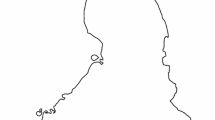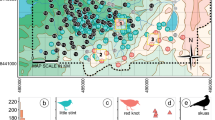Summary
The main ecological difference between the Great Reed Warbler (Acrocephalus arundinaceus arundinaceus) and Eastern Great Reed Warbler (Acrocephalus acrocephalus orientalis) lies in the density of breeding population, which in the Eastern subspecies studied in Japan is on average 10 times higher than that of European populations of the Western subspecies. In this study it is shown that potential food resources of the Great Reed Warbler in Japan are more than ten times more abundant than those in Poland, with respect both to the number of potential prey items (invertebrates) and to their total biomass. This strongly suggests that such high densities of Great Reed Warbler in Japan are at least partly due to more plentiful food supply. Other factors which could explain the difference between breeding densities in Japan and Poland are the predation by Marsh Harrier (Circus aeruginosus) in Poland and lack of competition with Reed Warbler (Acrocephalus scirpaceus) in Japan. The abundance of food on the sample plot in Japan resulted primarily from outbreaks of dipterans of the suborder Nematocera, the most common of which were Chironomidae. Although Chironomidae were not the preferred prey, they made up a substantial proportion of the diet of nestlings. In both studied areas, apart from dipterans, the greatest proportion of nestlings' diet constituted arachnids. Differences in nestlings' diet between study sites resulted mainly from a greater proportion of Nematocera and lower proportion of Coleoptera and Odonata in Japan.
Zusammenfassung
Die unterschiedliche Dichte der Brutpopulationen ist ein wichtiger ökologischer Unterschied zwischen den beiden Unterarten des Drosselrohrsängers (Acrocephalus arundinaceus). Im Durchschnitt ist die Abundanz bei der östlichen Unterart in Japan 10mal so hoch wie bei der europäischen Population der westlichen Unterart. Diese Untersuchung macht deutlich, dass das potentielle Nahrungsangebot in Japan mehr als 10mal so groß ist wie in Polen. Das gilt sowohl für die Anzahl der Beutetiere (Invertebraten) wie für die Biomasse. Es legt die Vermutung nahe, dass die große Populationsdichte des Drosselrohrsängers in Japan primär auf die enorme Nahrungsmenge zurückzuführen ist. Weitere Gründe könnten das Fehlen der Rohrweihe (Circus aeruginosus) sowie die fehlende Konkurrenz durch eine weitere Rohrsängerart sein. In Polen tritt neben dem Drosselrohrsänger in größerer Dichte der Teichrohrsänger (Acrocephalus scirpaceus) auf. Die hohe Abundanz von Nahrungstieren in Japan ergab sich in erster Linie durch das Massenschlüpfen von Mücken (Nematocera), besonders von Zuckmücken (Chironomidae). Obwohl sie nicht bevorzugt gefressen wurden, machten sie doch einen erheblichen Anteil an der Nestlingsnahrung aus. Neben den Fliegen (Diptera) stellten in beiden Untersuchungsgebieten die Spinnen (Araneae) den größten Anteil. Im Vergleich zu Polen fanden sich in Japan die größten Unterschiede in der Nestlingsnahrung bei einem höheren Anteil an Mücken und einem geringeren an Käfern (Coleoptera) und Libellen (Odonata).
Similar content being viewed by others
References
Anonymous (1996): StatXact 3 for Windows. Cambridge, MA.
Bujnicka, A. (1998). (Breeding ecology of the Great Reed WarblerAcrocephalus arundinaceus at Milicz). Diploma Thesis, Department of Avian Ecology, Wrocław University (in Polish).
Buś, B. (1997): (Breeding ecology and nestling diet of the Great Reed WarblerAcrocephalus arundinaceus at Milicz fish-ponds). Diploma Thesis, Department of Avian Ecology, Wrocław University (in Polish).
Cramp, S. (1992): The birds of the Western Palearctic: Vol. 6. Oxford.
Davies, N. B. (1976): Food, flocking and territorial behaviour of the Pied Wagtail (Motacilla alba yarellii Gould) in winter. J. Anim. Ecol. 45: 235–252.
Davies, N. B. (1977a): Prey selection and social behaviour in Wagtails (Aves: Motacillidae). J. Anim. Ecol. 46: 37–57.
Davies, N. B. (1977b): Prey selection and the search strategy of the Spotted Flycatcher (Muscicapa striata): a field study on optimal foraging. Anim. Behav. 25: 1016–1033.
Dunning, J. B., Jr. (1993): CRC handbook of avian body masses. Boca Raton.
Dyrcz, A. (1977): Polygamy and breeding success among Great Reed WarblersAcrocephalus arundinaceus at Milicz, Poland. Ibis 119: 73–77.
Dyrcz, A. (1979): Die Nestlingsnahrung bei DrosselrohrsängerAcrocephalus arundinaceus und TeichrohrsängerAcrocephalus scirpaceus an den Teichen bei Milicz in Polen und zwei Seen in der Westschweiz. Ornith. Beob. 76: 305–316.
Dyrcz, A. (1981): Breeding ecology of Great Reed WarblerAcrocephalus arundinaceus and Reed WarblerAcrocephalus scirpaceus at fish-ponds in SW Poland and lakes in NW Switzerland. Acta orn. 18: 307–333.
Dyrcz, A. (1986): Factors affecting facultative polygyny and breeding results in the Great Reed Warbler (Acrocephalus arundinaceus). J. Ornithol. 127: 447–461.
Dyrcz, A. (1995): Breeding biology and ecology of different European and Asiatic populations of the Great Reed WarblerAcrocephalus arundinaceus. Jap. J. Ornith. 44: 123–142.
Dyrcz, A. & Nagata, H. (1998): Effect of human activities on breeding ecology of the Eastern Great Reed Warbler. In: Adams, N. J. & Slotow, R. H. (Eds.): Proc. 22 Int. Ornithol. Congr., Durban. Ostrich: 69: 283.
Dyrcz, A. & Zdunek, W. (1996): (Potential food resources and nestling food in the Great Reed WarblerAcrocephalus arundinaceus and Reed WarblerAcrocephalus scirpaceus at Milicz fishponds). Ptaki Slaska 11: 123–132 (in Polish with English summary).
Ezaki, Y. (1992): Importance of communal foraging grounds outside the reed marsh for breeding Great Reed Warblers. Ecol. Research 7: 63–70.
Ezaki, Y. & Urano, E. (1995): Intraspecific comparison of ecology and mating system of the Great Reed WarblerAcrocephalus arundinaceus: why different results from different populations? Jap. J. Ornithol. 44: 107–122.
Flinks, H. & Pfeifer, F. (1987): Nahrung adulter und nestjunger Schwarzkelchen (Saxicola torquata rubicola) einer westfalischen Brutpopulation. Vogelwelt 108: 41–57.
Hałupka, L. (1998): (Breeding ecology of the Reed WarblerAcrocephalus scirpaceus at Milicz fishponds). Ptaki Slaska 12: 5–15 (in Polish with English summary).
Jenni, L., Reutimann, P. & Jenni-Eiermann, S. (1989): Recognizability of different food types in faeces and in alimentary flushes ofSylvia warblers. Ibis 132: 445–453.
Leisler, B. (1991):Acrocephalus arundinaceus — Drosselrohrsänger. In: Glutz von Blotzheim, U. & Bauer, K. (Eds): Handbuch der Vögel Mitteleuropas: Vol. 12: 488–539. Wiesbaden.
Leisler, B., Heidrich, P., Schulze-Hagen, K. & Wink, M. (1997): Taxonomy and phylogeny of reed warblers (genusAcrocephalus) based on mt DNA sequences and morphology. J. Ornithol. 138: 469–496.
Ralph, C. P., Nagata, S. E. & Ralph, C. J. (1985): Analysis of droppings to describe diets of small birds. J. Field Ornith. 56: 165–174.
Renkonen, O. (1938): Statistisch-ökologische Untersuchungen über die terrestische Käferwelt der finnischen Bruchmoore. Ann. Zool. — Bot. fenn. Vanamo 6: 1–226.
Richards, O. W. & Davies, R. G. (1977): Imms' general textbook of entomology: Vol. 2. London.
Saitou, T. (1976): Breeding biology of the Eastern Great Reed Warbler,Acrocephalus arundinaceus orientalis. Misc. Rep. Yamashina Inst. Ornith. 8: 135–156.
Tomialojc, L. (1970): (Quantitative studies on the synanthropic avifauna of Legnica and its environs). Acta orn. 12: 295–392 (in Polish with English summary).
Urano, E. (1990): Factors affecting the cost of polygynous breeding for female Great Reed WarblersAcrocephalus arundinaceus. Ibis 132: 584–594.
Witkowski, J. (1989): Breeding biology and ecology of Marsh HarrierCircus aeruginosus in Barycz Valley, Poland. Acta orn. 25: 223–320.
Author information
Authors and Affiliations
Rights and permissions
About this article
Cite this article
Dyrcz, A., Flinks, H. Potential food resources and nestling food in the Great Reed Warbler (Acrocephalus arundinaceus arundinaceus) and Eastern Great Reed Warbler (Acrocephalus arundinaceus orientalis). J Ornithol 141, 351–360 (2000). https://doi.org/10.1007/BF02462245
Accepted:
Published:
Issue Date:
DOI: https://doi.org/10.1007/BF02462245




